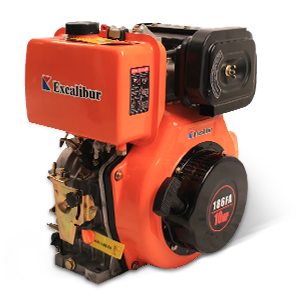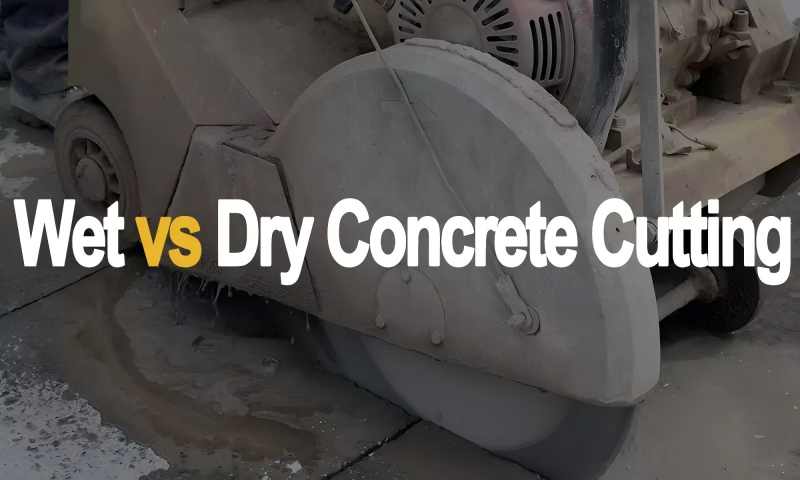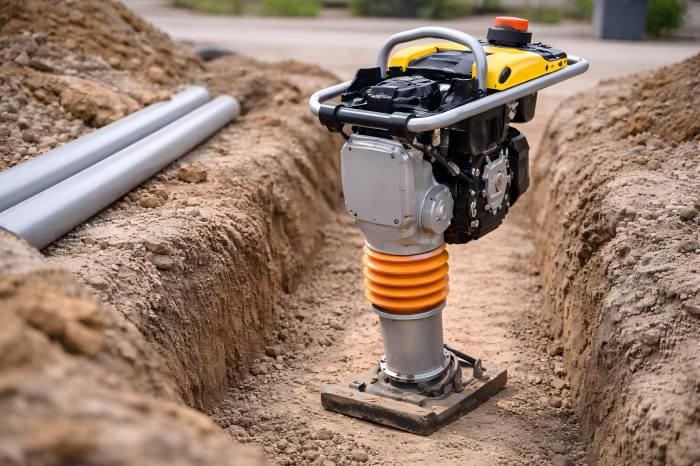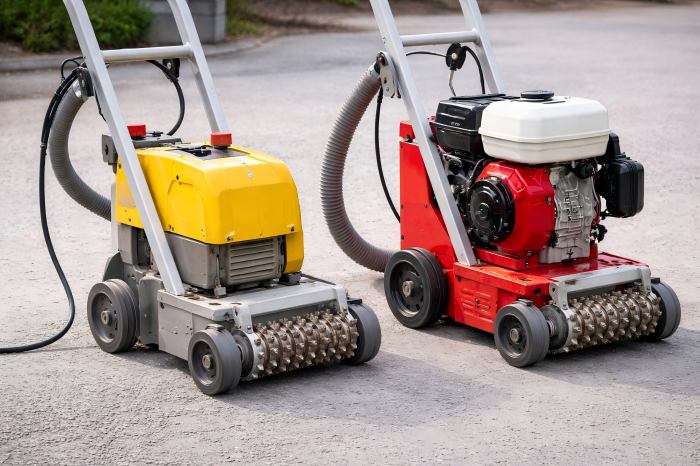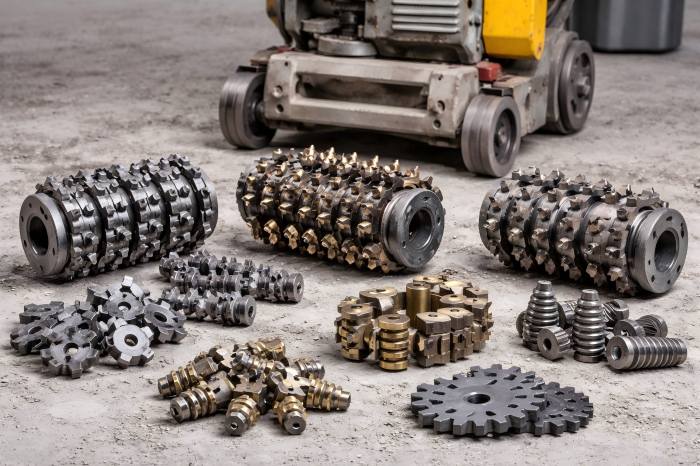Concrete cutting is a vital step in modern construction, and walk-behind saws play a central role in handling large surface cuts in floors, roads, and industrial slabs. One of the most critical decisions faced by contractors, operators, and project managers is choosing wet cutting or dry cutting methods.
Each has its benefits and limitations, and selecting the right one can significantly impact your cutting efficiency, blade life, and operator safety.
Cutting Methods
Concrete cutting involves abrasive or diamond blades rotating at high speeds to slice through hard surfaces like cured concrete, asphalt, or reinforced slabs. The process generates friction, heat, and dust. To address these challenges, two main cutting methods are used:
- Wet Cutting: Water is continuously fed to the blade during cutting.
- Dry Cutting: No water is used; instead, the cutting is done in dry conditions, often with airflow or vacuum systems to manage dust.
Both techniques are used across walk-behind saw models and have distinct implications for job site safety, blade life, cut quality, and environmental compliance.

What Is Wet Cutting?
The walk-behind saw is either connected to a continuous water source or has a built-in water tank that delivers water to the blade during cutting.
How It Works:
- Water is sprayed at the blade through nozzles near the blade guard.
- Water cools the blade and lowers the surface temperature.
- Dust particles are turned into slurry, preventing airborne inhalation risks.
Common Applications:
- Highway and road construction
- Industrial flooring
- Cutting reinforced concrete or asphalt
- Situations requiring deep cuts
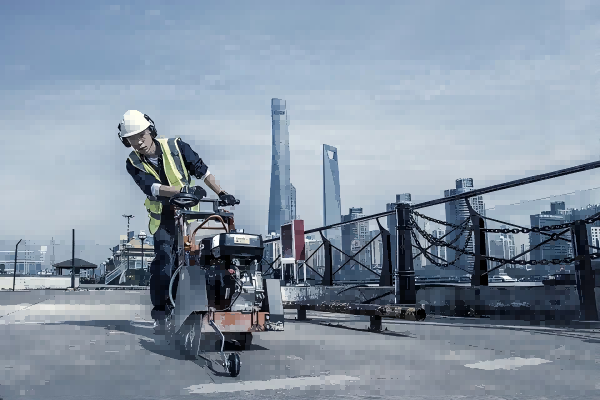
What Is Dry Cutting?
Dry cutting does not involve water. Instead, it relies on intermittent cutting and airflow to keep the blade temperature within safe limits. Walk-behind saws used for dry cutting are designed with ventilation slots and are often paired with dust collection systems.
How It Works:
- Operators make shallow, segmented cuts.
- Airflow and blade slots dissipate heat.
- Dust vacuums or shrouds are used to reduce airborne particles.
Common Applications:
- Small slab sections
- Indoor areas where water use is limited
- Decorative or segmented concrete scoring
- Emergency or short-duration cuts
Wet Cutting vs. Dry Cutting Comparison
| Feature | Wet Cutting | Dry Cutting |
| Dust Control | Excellent (slurry captures dust) | Poor without proper extraction |
| Blade Life | Longer due to cooling | Shorter due to heat buildup |
| Cutting Speed | Faster, continuous cuts | Slower, with breaks between cuts |
| Work Environment | Requires water supply | Suitable for water-restricted areas |
| Material Suitability | Cured concrete, asphalt, rebar | Bricks, soft concrete, pavers |
| Operator Safety | Reduced silica dust risk | Higher dust exposure without PPE |
| Cleanup Needs | Slurry must be managed | Minimal wet cleanup |
| Compliance | OSHA-compliant with dust suppression | Needs dust control system for compliance |
| Noise Levels | Slightly lower | Higher due to lack of dampening |
Choosing the Right Blade for Wet and Dry Cutting
Wet Cutting Blades:
- Usually features segmented or continuous rim diamond blades.
- Engineered for water use to reduce overheating and blade warping.
- Allow deeper and longer-duration cuts.
- Ideal for walk-behind saws on large outdoor job sites.
Dry Cutting Blades:
- Often turbo or segmented rim with heat-resistant cores.
- May include ventilation slots for air cooling.
- Must be used with proper rest intervals to prevent heat damage.
- Generally used for handheld saws, but some walk-behind models support them with built-in dust extraction.
Important: Using a dry-cutting blade with water can damage the blade, while wet-cut blades used dry may overheat, reducing life and increasing risk of breakage.
Performance and Productivity Comparison
Wet Cutting: High Performance and Efficiency
Wet cutting is typically quicker and more effective for deep, continuous cutting tasks. The presence of water minimizes blade wear and allows longer uninterrupted operation. In large concrete jobs, wet cutting can save hours.
Dry Cutting: Limited But Flexible
Dry cutting is more suitable for small to medium jobs, especially where access to water is limited. However, overheating risks mean operators must frequently pause to let blades cool, reducing productivity.
Case Example:
- Cutting a 6” thick reinforced concrete slab over 100 linear feet:
- Wet Cutting can be done in about 3–4 hours with two blade changes.
- Dry Cutting may take 5–6 hours due to pauses and may require 3–4 blade changes.
Health & Safety Considerations
Silica Dust Exposure
- Cutting concrete or masonry releases silica dust, which may lead to silicosis or lung cancer.
- Wet Cutting controls this hazard by binding dust particles with water.
- Dry Cutting without proper dust control poses a serious health hazard and often violates OSHA and local workplace safety standards.
Regulatory Compliance
- OSHA enforces strict standards under 29 CFR 1926.1153 for silica exposure.
- Employers must use wet cutting or provide proper engineering controls (HEPA vacuums) and PPE when dry cutting.
Initial and Operating Costs Comparison
| Cost Element | Wet Cutting | Dry Cutting |
| Blade Cost | $200–$500 per blade | $150–$400 per blade |
| Blade Lifespan | 1000–2000 linear feet | 600–1000 linear feet |
| Machine Maintenance | Higher due to water system wear | Lower but more frequent blade swaps |
| Dust Control Equipment | Minimal (just water tank) | High (HEPA vacuums, PPE) |
| Labor Cost (Time) | Lower due to faster cutting | Higher due to pauses, dust handling |
Although wet cutting may involve additional setup and water management, it usually provides a lower total cost of ownership over time due to reduced blade consumption and faster operation.
Application Suitability: When to Use Which
Wet Cutting is Ideal For:
- Outdoor concrete slab cutting
- Asphalt road cutting
- Large commercial flooring projects
- Deep expansion joints
Dry Cutting is Preferred For:
- Indoor renovation jobs
- Environments where water is restricted (e.g., electrical proximity)
- Small jobs or tight spaces
- Emergency repairs
Environmental Considerations
Wet Cutting
- Creates slurry (mixture of dust and water) which must be cleaned and disposed of properly.
- May lead to runoff issues if not managed.
Dry Cutting
- Produces airborne dust which can settle on surrounding surfaces.
- Creates more hazardous waste in terms of fine particulate matter.
Tip: Wet cutting is generally more environmentally responsible when runoff is managed.
Equipment Design Considerations
As a walk-behind saw manufacturer, we offer models designed for both wet and dry cutting:
| Feature | Wet-Cut Walk-Behind Saw | Dry-Cut Walk-Behind Saw |
| Integrated Water Tank | Yes | Optional |
| Dust Port for Vac Attachment | Optional | Yes (standard) |
| Blade Guard Design | Enclosed with water feed lines | Vented with dust shields |
| Cooling System | Water-cooled | Air-cooled |
| Applications Supported | Concrete, asphalt, joint cutting | Masonry, indoor tile, light slabs |
Choosing the Right Method for Your Walk-Behind Saw
Use Wet Cutting If:
- You’re working outdoors or in ventilated areas.
- Your job involves deep or continuous cuts.
- You’re cutting reinforced concrete or asphalt.
- You need to extend blade life and ensure clean cuts.
- You’re aiming for OSHA silica dust compliance.
Use Dry Cutting If:
- Water access is restricted, or water use is prohibited.
- You’re working in occupied or sensitive indoor areas.
- The job is small-scale or temporary.
- You have access to proper dust control systems.
- You’re performing score lines or segmented cuts.

